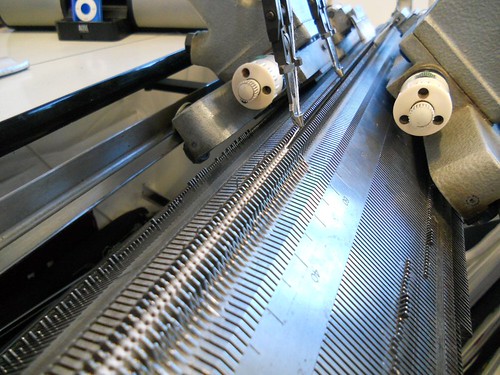Claire showed me several cast ons, one of which was pretty much the standard circular cast on. Then we had a play producing various ribs, half milano and full milano - names I've seen in that Susanna Lewis book, but never gotten around to exploring. We did some stuff with pleats, including a racked pleat that is such a lovely texture I've been trying to think what I could use it for all weekend. I do love the fineness of the fabric produced (most of what we did was full needle rib with a 1 or 2ply yarn). The Cog has no need to panic, though - even if I wanted such a machine, there's no way I'd ever have enough space for one (let alone the money!).
Claire was lovely (and very brave letting a stranger play on a most expensive and delicate machine) - and she has a lot more knitting machines than me, so I feel somewhat of a lightweight in that department! :)
A most enjoyable day. Took some shots of the machine, I did come home with some swatches and will photograph them and add them here, but as they're not labelled I might not be able to identify all of them!
Now I really want to get my finegauge machine out...! Must get my behind in gear and finish up the midgauge jumper, then, as it's in the only spare slot.
In other news, the transformer for my PC10 has died a death - the wonderful Richard Croucher is going to make me a replacement from a laptop charger. I only bought the device in 2011 to diagnose a fault with the also brand new SK860 (which had a wonky back rail). Nothing is well-made these days, it seems.



Current mood:
 inspired
inspired

5 comments:
Wow! Lucky you.
Lucky, lucky you!!! I'd jump on that opportunity in a New York minute! I've been following Claire online, in fact just "pinned" a bunch of her photos (or photos of her stuff) yesterday.
Thanks for this great post.
Feeling: envious ;-)
Thanks for sharing this great adventure.
Any chance you could share your view on high and low butt needles in comparison to the needle positions Brother uses? Been trying to understand that bit for ages.
I'm always thinking you must be knitting different stripes of patterns if the needles won't move sideways ;-)
Thx
Ben
Hi Ben,
Yes, all you get is stripes with this method - so you knit a bit that picks up the stripe (eg tuck one way, knit the other) and then you knit a bit that ignores the butts and get plain. A domestic machine is far more versatile! When I get around to it I'll post the swatch pictures and you'll see what I mean.
If I remember correctly, a high butt is somewhat equivalent to a needle being in D position (knitting all the time) and low butt is like B (tucking or slipping, depending on cam setting). It's been a while since I worked on either machine, but I think that's the key.
Post a Comment